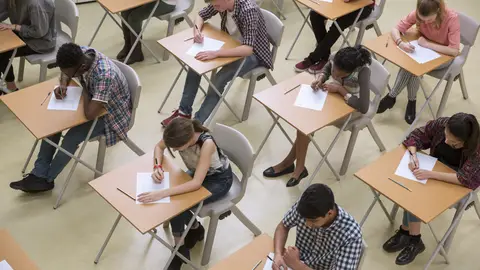A Teacher Made Students "Bid" On Black Classmates In A Racist Slave Auction

By Lauren Rearick
On two separate occasions, fifth grade students at The Chapel School in Bronxville, New York, were made to participate in a racist reenactment of a slave auction wherein Black students were made to be slaves by their teacher and white students were instructed to “bid” on them, an investigation from New York Attorney General Letitia James concluded in a press release published on May 29.
An investigation into the school, which is accredited by National Lutheran Schools and Middle States Association of Colleges and Schools, started after James received a report of the mock auction. It was discovered that a social studies teacher at The Chapel School had asked Black students in two separate classes to raise their hands and then stand in the hallway. The teacher placed the Black students in imaginary chains or “shackles” before leading them back into the classroom; white students were then asked to participate in a “simulated auction” of their classmates.
The instructor had denied holding a racist mock auction, telling PIX11 that she “separated Black and white students to drive home a history lesson about slavery.” She was ultimately terminated by the school, but as James’s findings noted, the impact’s reenactment on the students, particularly the Black students, was “profoundly negative.”
Based on the results of the investigation, The Chapel School is required to make significant changes to its education and discipline policies; James said complaints regarding the school’s “lack of racial sensitivity” were made before the March incident.
In a statement given to MTV News, Principal Michael Schultz said that the school, which teaches kindergarten through eighth grade, “accepts responsibility for the findings and are committed to implementing all items outlined by the Attorney General to help us deepen our cultural competence.”
He said the school took action “immediately” following the incident, and sought to provide the students with support from religious and third-party mental health groups. He says the school has also hired someone “to lead anti-discrimination discussions with our community and begin planning for a comprehensive review of our curriculum and practices.”
Going forward, the school is to hire a Chief Diversity Officer, approved by the Attorney General; develop a plan to diversify their staff and “increase minority representation” among educators; dedicate financial aid to “maintain and increase diversity” among students; create a new Code of Conduct that’s to be approved by the Attorney general; create a Disciple Reform Plan; work with a Diversity Consultant that can better educate students and staff on “racial/ethnic diversity and sensitivity; and create a better system for students and parents to report instances of harassment or discrimination.
While the racist class exercise may seem singular to The Chapel School, Vox points out that many schools are still failing to accurately teach students about the very real horrors of slavery. “Although we teach [students] that slavery happened, we fail to provide the detail or historical context they need to make sense of its origin, evolution, demise and legacy,” Hasan Kwame Jeffries, an associate professor of history at Ohio State University, wrote in a 2018 study published by the Southern Poverty Law Center. “And in some cases, we minimize slavery’s significance so much that we render its impact—on people and on the nation—inconsequential.”
The ramifications of slavery can still be felt by Black Americans today, and many of them are forced to navigate various inequities that their white counterparts do not. Despite students of color making up the majority of public school attendance, racial disparities in education continue to exist. A 2016 study completed by the American Civil Liberties Union and the Department of Education found that white students are more commonly placed in gifted or advanced education programs, while Black students are more likely to lose out on educational opportunities due to an increase in suspension among students of color. Racial disparity can lead to a lack of quality education for Black students, and in turn, can affect their preparedness level for college.
It’s that inequity that James hopes the Chapel School will directly address; it remains to be seen if other schools across the country will follow suit. “Every young person – regardless of race – deserves the chance to attend school free of harassment, bias, and discrimination,” James said. “Lessons designed to separate children on the basis of race have no place in New York classrooms, or in classrooms throughout this country.”





